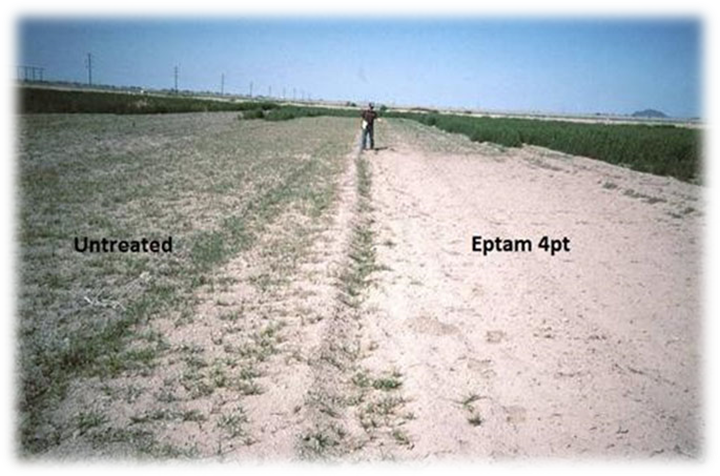Jul 23, 2014
Nutsedge Control with EPTC(Eptam) and Summer Fallow 2014
Nutsedge is one of the most difficult to control weeds in Arizona and worldwide. It is a perennial that spreads vegetatively with below ground tubers that can stay viable for many years. Both yellow and purple nutsedge are common throughout Arizona. Most of it is purple which is the more difficult to control of the two. There are few herbicides that will completely control nutsedge and it is so prolific that even fairly high levels of control last only one season. Most herbicides need to be used for several consecutive years to keep this weed in check.
When nutsedge infestations get worse every year it can become beneficial to combine summer fallow with chemical treatment to break the cycle and get the problem under control. One of the most effective and economical treatments for nutsedge control is Eptam (EPTC) combined with summer fallow. This technique can be highly effective but it can also completely fail if proper application and cultural practices are not followed. It was developed 25 years ago but is still often misunderstood. The following six principals are important for this technique to be effective:
1) Both above ground shoots and below ground tubers must be destroyed. Emerged shoots will provide nutrients for the production of new below ground tubers. Viable below ground tubers will produce new rhizomes, basal bulbs and above ground shoots. Tillage and some herbicides such as glyphosate can be used to destroy above ground shoots. The Eptam fallow treatment will destroy rhizomes as they attempt to reach the surface.
2) Eptam is one of the most volatile herbicides available. It is lost in several ways including microbiological and photochemical decomposition but the most common means of losing EPTC in the irrigated southwest is by contact with water. It volatizes from irrigation water, off of wet soil and is leached deep into the soil. It should be incorporated into dry soil where it will remain active for a much longer period of time. It should not be irrigated after application unless the objective is to move it down to contact deep tubers or to remove it in preparation for the planting of a susceptible crop.
Red sprangletop is, in general, a lighter green color and has a finer seed head than does Mexican sprangletop which is darker green or gray and has a visibly coarser seedhead. Both form clumps or crowns that often survive through the winter months. Both are fairly tolerant to Poast (sethoxydim) and Fusilade (fluaziflop) but are controlled with high rates of Select (clethodim).
3) Eptam works on those parts of the nutsedge plant that are trying to grow (rhizomes and shoots). It works best on stressed plants but will have no effect on nutlets that are dormant. Enough moisture should be made available to stimulate nutsedge growth but under stressed conditions. An irrigation may be necessary. Once the top 6 inches is dry the Eptam should be applied and incorporated.
4) A chemical tarp is created with the surface application of Eptam that will prevent shoots and rhizomes from reaching the surface. The surface should, therefore, be left as smooth as possible. Any untreated areas or breaks in the surface from implements, wheels or even footprints will allow shoots to emerge.
5) Eptam should not be applied too early (April or May) because of possible degradation prior to the period of rapid nutsedge growth or too late (August or September) because of decreasing growth and potential injury to fall planted crops.
6) To avoid injury to following crops, irrigate at least 30 days prior to planting. The Eptam label specifies "Do not plant cotton or crops not listed on the Eptam label for 90 days after application."
Real IPM

To contact Marco Pena go to:
marcop@ag.arizona.edu








